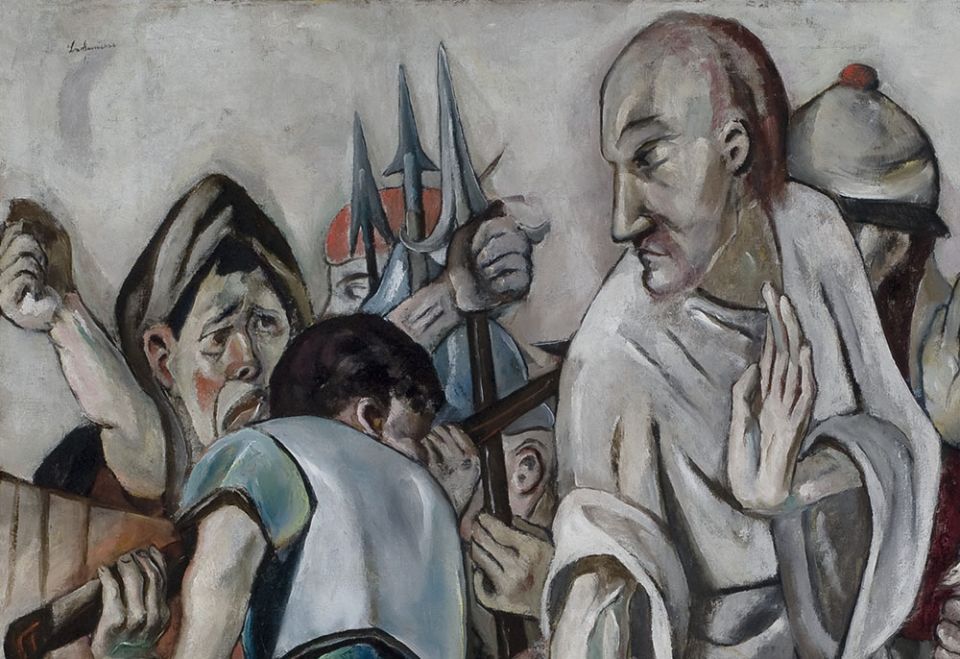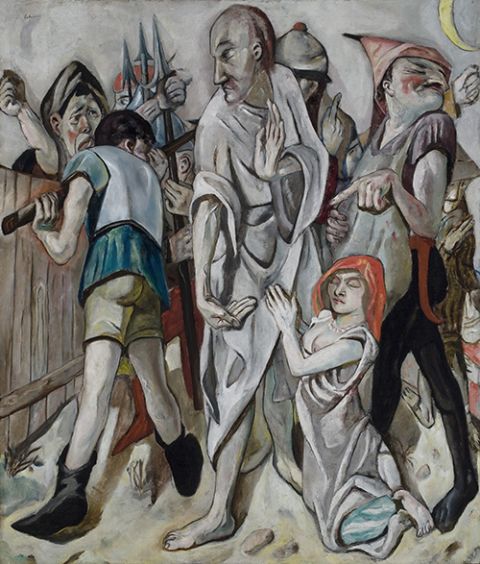Christ and the Sinner detail.jpg

She should be stoned to death, her accusers say. In John 8:2-12, Jesus' opponents bring to him a woman they claim was caught in adultery, cite legal justification for executing adulterers, and ask Jesus: "What do you say?"
Jesus ignores their question and instead bends down and starts to write on the ground with his finger, the first step of his nonviolent act of resistance. The woman's accusers continue to press Jesus for an answer, so he stands and says, "If any one of you is without sin, let him be the first to throw a stone at her." He then returns to writing on the ground.
Jesus' reply brilliantly turns the tables on the woman's accusers — they become the accused — and one by one they depart, leaving Jesus alone with the woman. For the first time in this story, she is invited to speak and confirms to Jesus that no one is left to accuse her.
The accusers thus never get to hear Jesus answer their "What do you say?" question. He says to the woman, "Neither do I condemn you."
9.10.22 Beckmann Self-Portrait.jpg

Jesus shifts the focus from the woman as sinner to the accusers as sinners, those who abuse power, lack compassion and are painfully unaware of their own sinfulness. They do not seek justice; the narrator explains, for example, that Jesus' opponents are trying to trap him so they could "have some charge to bring against him." Other details of the story reinforce that assessment: otherwise, they would have also brought the male involved in the alleged adultery (Leviticus 20:10) and the witnesses required by law (Deuteronomy 19:15).
The woman's accusers, by slinking away one by one, implicitly confess that they are also "sinners," but there is no indication that they recognize the woman as their social and human equal. Jesus treats her as a person of worth, and the story advocates that readers and viewers should do the same. Jesus thus urges both his opponents and the woman to re-evaluate, to change their beliefs and actions and to not "sin anymore."
This story complements the story in Luke 7:36-50 of the woman "who was a sinner" anointing the feet of Jesus, thus becoming the unwelcome center of attention at a dinner in which Jesus was a guest. In his response, Jesus asks the shocked host, "Do you see this woman?" On one level, Jesus was surely joking. No one could have missed her! On another level, however, he also could be asking his host if he really sees the woman as she is — a child of God deserving of love, compassion and respect as a person of equal value and worth.
Similarly, in the story of the woman allegedly caught in adultery in John 8, after her former accusers steal away, Jesus asks her, "Woman, where are they? Has no one condemned you?" The slightly sarcastic humor in Jesus' questions to/about these two "sinful" women focuses attention in both stories on the accusers' lack of recognition of their own sinfulness, the women's value and dignity, and the necessity of restoring community.
Max Beckmann's painting, "Christ and the Sinner," similarly raises many intriguing questions, and it also merges the story of the adulterous woman in John 8 with the story of the "sinner" woman in Luke 7 (e.g., Beckmann's labeling her a "sinner" in his description of the painting).
Christ and the Sinner RESIZE.jpg

This painting reflects the horrors Beckmann (1884-1950) experienced during his medical corps service in World War I. Suffering from complete mental and physical exhaustion, he was discharged from the army in 1915, and his paintings during this era were religious protests. As he said in 1919: "In my paintings I accuse God of his errors. … My religion is hubris against God, defiance of God, and anger that he created us [such] that we cannot love each other."
"Christ and the Sinner" starkly expresses human themes of cruelty, anger, guilt and suffering. Beckmann's use of space produces a sense of dread; the disjointed figures are displayed in a compact, narrow and agitated space; pale colors and angular forms create an almost nightmarish scene that draws viewers into the painting.
What one first notices in the array of figures, however, are their hand gestures: the man behind the fence with fists clenched in anger. The hands of the soldiers bend backward as they seek to restrain the crowd, with their spears creating a cross-like image directly behind Jesus. The woman who kneels beside Jesus has her hands clasped in supplication. The hand of the clownlike man turns his head in disdain and points an accusatory finger, not at the woman, but at the right hand of Jesus that is cupped and accepting the woman's prayerful gesture. Jesus' left hand indicates that he resolutely opposes the unruly and incoherent mob.
Strikingly, only two people clearly have their eyes open: the angry man behind the fence, and Jesus, who glares at him in response. The closed eyes of the other figures, along with their chaotic placement, emphasizes their detachment and lack of community.
Yet two figures are joined in community: Note, for example, how the colors of the painting, except for the woman's reddish-orange hair, unite the woman and Jesus through their lighter-colored clothing.
Jesus stands at the horizontal center of the painting and his figure spans almost the entire vertical axis. By Jesus' right foot lies a stone that will remain uncast, because of Jesus' intervention on the woman's behalf.
Advertisement
Advertisement
Beckmann's portrayal of Jesus — balding, beardless and with a prominent chin — is a self-portrait similar to one he painted in 1917 that also includes a cross-like symbol directly behind him. This self-portrait and his Jesus self-portrait in "Christ and the Sinner" reflect Beckmann's reproaches against God and his accusations against an inhumane society.
Although interpretations of works of art should be informed by the contexts in which they are created, the nature of art demands that interpretations cannot be limited to those contexts. Meaning, like beauty, is at least partially in the eyes of the beholders.
I argue that Beckmann's "Christ and the Sinner," like the story it represents, offers a disturbing but also potentially restorative vision of human existence in an inhumane world.
Although Beckmann may have intended the painting to reflect his anger against God — placing himself in the role of Jesus amidst an unruly mob — it instead can be read as a call to speak and act as Jesus did: Putting ourselves in the role of Jesus in these stories. Not only speaking of God in an inhumane, turbulent world but speaking for God — offering words and actions that promote reconciliation, restoration and community in a world that seems all too eager to reject them. To accomplish those goals, one must also strive to believe, contrary to Beckmann, that God has created us so that we can love each other in this inhumane world.



